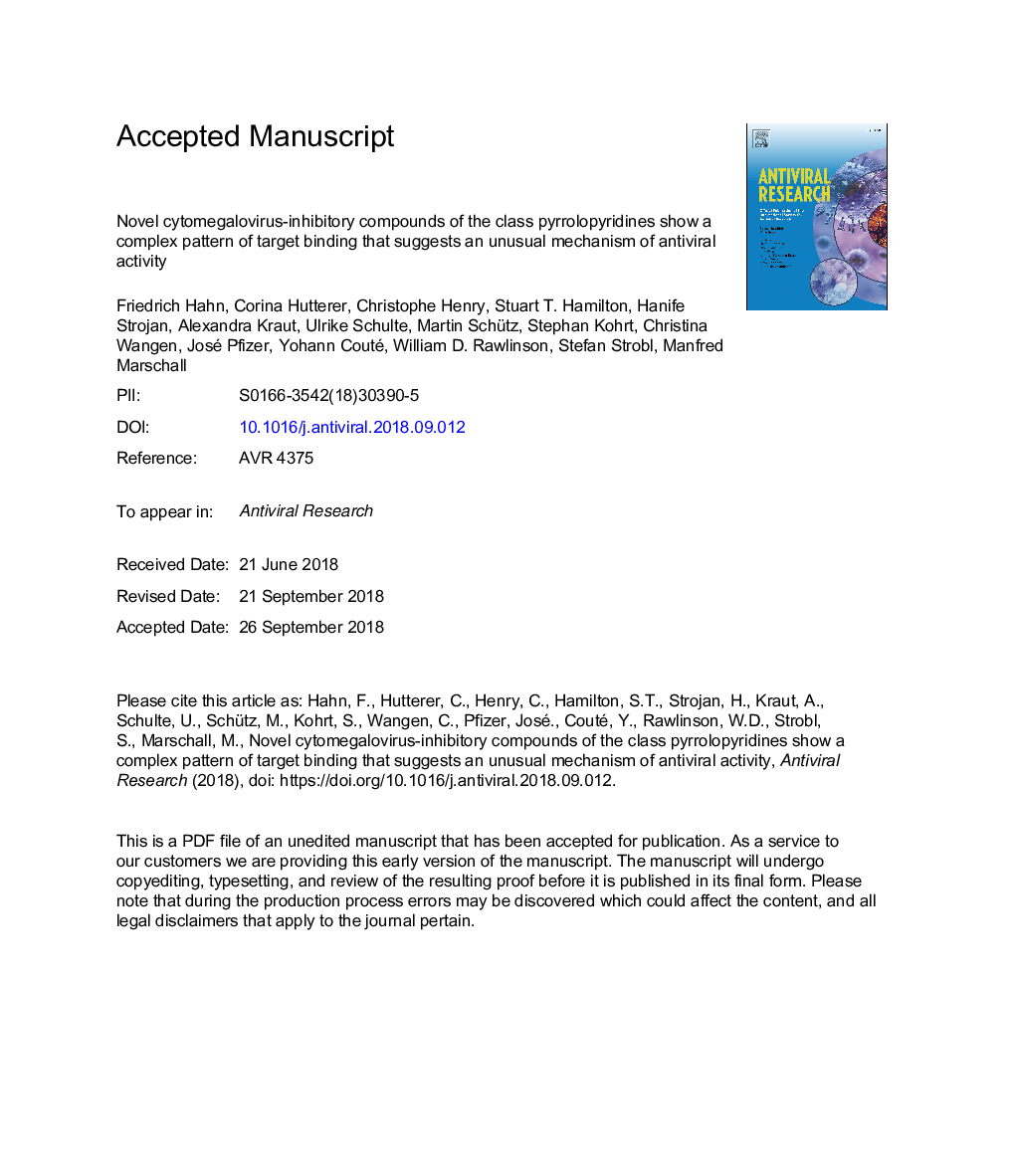| کد مقاله | کد نشریه | سال انتشار | مقاله انگلیسی | نسخه تمام متن |
|---|---|---|---|---|
| 11025747 | 1666521 | 2018 | 38 صفحه PDF | دانلود رایگان |
عنوان انگلیسی مقاله ISI
Novel cytomegalovirus-inhibitory compounds of the class pyrrolopyridines show a complex pattern of target binding that suggests an unusual mechanism of antiviral activity
ترجمه فارسی عنوان
ترکیبات مهار کننده سیتومگالوویروس نوظهور از پیرولوپرویدین های کلاس، الگوی پیچیده اتصال دهنده هدف را نشان می دهد که نشان می دهد مکانیسم غیر معمول فعالیت ضد ویروسی
دانلود مقاله + سفارش ترجمه
دانلود مقاله ISI انگلیسی
رایگان برای ایرانیان
کلمات کلیدی
سیتومگالوویروس انسان ترکیبات ضد ویروسی، توسعه داروهای تجربی، بی حرکت سازی مواد مخدر توسط لینک دهنده، شناسایی هدف مبتنی بر طیف سنج جرمی، خواص بیولوژیکی و حالت عمل،
موضوعات مرتبط
علوم زیستی و بیوفناوری
ایمنی شناسی و میکروب شناسی
ویروس شناسی
چکیده انگلیسی
Human cytomegalovirus (HCMV) is a major human pathogen with seropositivity rates in the adult population ranging between 40% and 95%. HCMV infection is associated with severe pathology, such as life-threatening courses of infection in immunocompromised individuals and neonates. Current standard therapy with valganciclovir has the disadvantage of adverse side effects and viral drug resistance. A novel anti-HCMV drug, letermovir, has been approved recently, so that improved therapy options are available. Nevertheless, even more so far unexploited classes of compounds and molecular modes of action will be required for a next generation of antiherpesviral treatment strategies. In this study, we focused on the analysis of the antiviral potency of a novel class of compounds, i.e. pyrrolopyridine analogs, and identified both hit compounds and their target protein candidates. In essence, we provide novel evidence as follows: (i) screening hit SC88941 is highly active in inhibiting HCMV replication in primary human fibroblasts with an EC50 value of 0.20â¯Â±â¯0.01â¯Î¼M in the absence of cytotoxicity, (ii) inhibition occurs at the early-late stage of viral protein production and shows reinforcing effects upon LMV cotreatment, (iii) among the viruses analyzed, antiviral activity was most pronounced against β-herpesviruses (HCMV, HHV-6A) and intermediate against adenovirus (HAdV-2), (iv) induction of SC88941 resistance was not detectable, thus differed from the induction of ganciclovir resistance, (v) a linker-coupled model compound was used for mass spectrometry-based target identification, thus yielding several drug-binding target proteins and (vi) a first confocal imaging approach used for addressing intracellular effects of SC88941 indicated qualitative and quantitative alteration of viral protein expression and localization. Thus, our findings suggest a multifaceted pattern of compound-target binding in connection with an unusual mode of action, opening up further opportunities of antiviral drug development.
ناشر
Database: Elsevier - ScienceDirect (ساینس دایرکت)
Journal: Antiviral Research - Volume 159, November 2018, Pages 84-94
Journal: Antiviral Research - Volume 159, November 2018, Pages 84-94
نویسندگان
Friedrich Hahn, Corina Hutterer, Christophe Henry, Stuart T. Hamilton, Hanife Strojan, Alexandra Kraut, Ulrike Schulte, Martin Schütz, Stephan Kohrt, Christina Wangen, José Pfizer, Yohann Couté, William D. Rawlinson, Stefan Strobl, Manfred Marschall,
